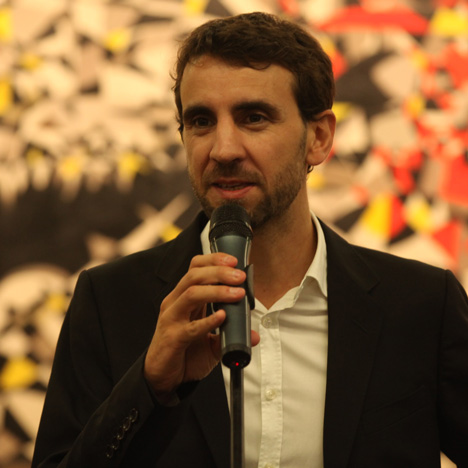
"It’s more than a technological revolution; it's a cultural revolution" - Joseph Grima
News: new technologies are causing a "cultural revolution" that will transform the way objects are made and the way they look, according to the curator of Adhocracy, a new exhibition exploring the impact of digital networks and open-source thinking on the design world (+ interview transcript).
"It’s more than simply a technological revolution; it's a cultural revolution we’re undergoing now," said Domus magazine editor Joseph Grima, who curated the exhibition as part of the inaugural Istanbul Design Biennial, which opened this weekend: "And I think this is just the beginning."
Rigid top-down systems established to optimise mass production in the last century are being replaced by flexible peer-to-peer networks, leading to new aesthetic codes and the destruction of the idea of the designer as author, Grima told Dezeen.
He added: "It ultimately boils down to the emergence of the network as the productive model par excellence of our time. It’s a complete shift away from the heroic figure of the designer towards the absence of any single figure as the author; more of a collaborative, networked approach. Every era has had its own aesthetics, its own codes, and the codes of this era are definitely of a very different kind to those of the previous century."
Grima spoke to Dezeen last Friday along with associate curators Ethel Baraona and Elian Stefa after the opening of the Adhocracy exhibition, one of two main components of the biennial.
The Istanbul Design Biennial is organised by Istanbul Foundation for Culture and Arts (IKSV) and runs until 12 December 2012. Adhocracy is at Galata Greek Primary School while Musibet, an exhibition curated by Turkish architect Emre Arolat exploring the rapid and chaotic growth of Istanbul, is at Istanbul Modern.
Below is an edited transcript of the interview conducted by Dezeen editor-in-chief Marcus Fairs, interspersed with photos from the exhibition:
Marcus Fairs: First of all, please explain who you are and your role on the exhibition.
Joseph Grima: I'm editor of Domus and curator of the Adhocracy exhibition.
Ethel Baraona: I'm editor from DPR Barcelona and associate curator of the Adhocracy exhibition.
Elian Stefa: Elain Stefa, associate curator of the exhibition and general coordinator.
Marcus Fairs: Tell us about the exhibition you’ve all worked on.
Joseph Grima: The exhibition is an attempt to understand and trace the lines of force that are redefining what design is today. And this is manifesting itself through all sorts of different aspects of everyday life. We wanted to really look at design not as something in a Salone del Mobile, furniture fair way but something that is the art of producing the objects that define who we are. And therefore to interrogate them in a way as to what is unfolding in this particular moment of radical change, in response in particular to the advent of new technologies: new relationships being born between people on a peer-to-peer basis rather than on a typical economic model of top-down bureaucracy.
Marcus Fairs: What does Adhocracy mean?
Joseph Grima: It’s a word that’s been used since the 1970s. I think Alvin Toffler first proposed it. It hints at the idea that the traditional organisation not just of labour but of production – the paradigm of industrial production - that was prevalent in the twentieth century is one of rigidity. It has a very clearly marked set of rules, it’s extremely hierarchical, it’s organised by levels of control.
And this is something that, in the period of history in which it was conceived, served to streamline the process of production. It was based on the idea of the creation of multiple objects; multiple objects that would run into the millions that were all exactly the same. The paradigm of industrialisation is standardisation and replication. And this of course for many decades was an extremely advantageous model. Fordism of course was a direct consequence of the theory of bureaucracy.
But at some point it also became evident that there was an inherent rigidity to this model. It was incapable of embracing change, incapable of adapting to complex situations. And that’s when this idea of Adhocracy in the early seventies started to emerge in many different fields: in the field of corporate culture organisation, the field of design with Charles Jencks’ Adhocism and many others. And in a way, what we considered to be an idea that was somewhat behind its time, has come to its full impact on society today. So the exhibition is an attempt to sample from a variety of different fields, not just from what we’d normally consider the design world, but also outside that; to sample a number of projects that are representative of the capillary seeping of this idea of Adhocracy into everyday life.
Marcus Fairs: As you say there’s not just design projects in the show: there’s a journalism project, a music project, a film project. Ethel, walk us through the exhibition briefly and give us some specific ideas of things that are in the show.
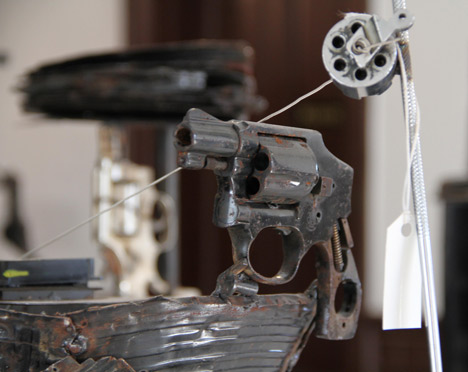
Ethel Baraona: As Joseph was saying, it deals with these new changes and how new technology allows us nowadays to do new kinds of designs. It also has social and political implications. For example Pedro Reyes’ Imagine piece [above and below] is fantastic because it’s a critique of the weapons business, which is everywhere in the world. He transforms them into musical instruments, to try to give another kind of message. People understand it’s a kind of business that should stop right now. We have some other projects that are not static objects, that are urban actions – and people who are in the basement are actually doing stuff while the exhibition is going on. I think these represent very clearly the Adhocracy concept.
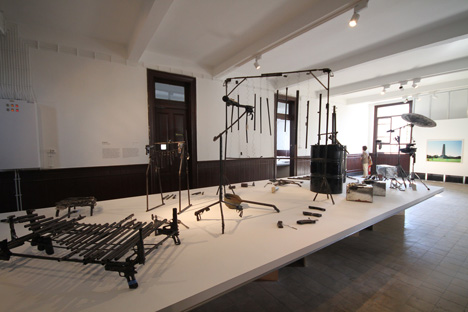
Marcus Fairs: Give some more examples.
Elian Stefa: For example on the roof of the exhibition we have UX, which is something completely different from everything else. These guys are a collective from Paris and they go underground. Basically they’ve explored the whole of the [Parisian network of catacombs] and they’ve taken over a section of the city. So it’s a whole approach to design that is completely radical and completely unforeseen in these kinds of exhibitions.
We wanted to show that design is not - was never - limited to just product design, but that design has a much larger scope. Design as a way to solve problems, even as a way to cure boredom. I mean you have seventeen-year-olds who are sending Lego men into space out of their back yards. It’s just about creativity and finding these kinds of solutions. What design means now is not really product design; it’s not even commercial in any way.
Joseph Grima: I think this is a really important point: the evolving idea of what the designers’ role is. So if there is a third industrial revolution unfolding around us - which is very clearly visible in the technology that is being used to produce objects - it no longer forces us to produce millions all exactly the same but can actually offer much more personalisation; it can return to the model of the craftsman in the workshop.
At the same time the role of the designer is evolving. Projects that are emblematic of this are [modular construction system] OpenStructures, [open-source microprocessor] Arduino; projects that are not about creating objects but about creating systems for other people to adapt, and to create objects out of them. It’s a little bit like an iPhone: it can be many things for different people depending on the apps you install. And for developers, depending on how they utilise the hardware that’s built into an iPhone, it can be anything. And that’s increasingly an incredibly interesting paradigm of design today: not creating something that’s closed and finished, but something that’s open and that can be interpreted. That’s exponentially more powerful.
Elian Stefa: The key words are process and platform. It’s a way to build on things; things that are not finalised. They continue growing afterwards.
Ethel Baraona: It also deals with subjects like economics, copyright and patents. Maybe this third industrial revolution is changing now also in these kind of terms. Artificial intelligence and collaborative production are changing all of the concepts we have learned over the years; so we wanted to show this also.
Marcus Fairs: You mentioned the UX project. They broke into a historic building and made some alterations but they were positive alterations. But you could also look at that as a criminal act. You could break in and do some damage. There’s also a film in the exhibition about a drone that flew over the streets of Warsaw during the riots and was used as a journalistic tool. But drones were developed by the military for other kinds of uses. Also the 3D-printed gun, which was in the news lately, isn’t in the show. There are open-source websites where people share stolen credit cards details. A lot of these technologies can be used for sinister means. Why is this an edit only of positive applications?
Joseph Grima: We didn’t actually edit out the negative connotations. If the whole thing about the guns had come out a little bit sooner we certainly would have put it in, even though we’d have probably got in some trouble in this day and age in Turkey for trying to 3D print a gun. Nevertheless what we were trying to point out is the ambiguities inherent in new technologies. It’s a well-known conundrum that the human spirit is naturally driven to innovation and creation and, as with the nuclear bomb, it can be used in two distinct ways. And that’s always going to be the case.
But what we were more interested in in this particular case, with UX for example, this idea that in fact something that is, according to the bureaucracy of law, completely illegal and should not happen, was actually capable of producing something positive: to bring back to its former glory one of the monuments of Paris. There’s a suspicion that anybody who breaks into a building is automatically bad and I think what’s really interesting today is that law itself, and legality – and what Ethel was talking about, the systems of copyright and intellectual protection and so on, law itself.
If we’d had more time and a larger exhibition, legality and judicial issues would have made a really interesting chapter. Legal systems are having to evolve incredibly quickly to deal with challenges that could they never even have conceived of three of four years ago. So it’s about this rapid change in which the structures of power, the structures of authority, are often paradoxically at a disadvantage, despite their incredible endowment of funds. This kind of tactical approach of the crowd, the masses, the individuals grouping together, is an almost irresistible force. It’s something that can hardly be overcome.
Marcus Fairs: In some ways manufacturing is behind other industries. Publishing for example was transformed by technology twice in recent years – first the desktop publishing revolution, which allowed anyone to create newsletters, magazines, posters and so on, and then more recently by online platforms like blogs. The music industry has been through a complete meltdown, thanks to file sharing. Why has manufacturing been slow to adopt these models and what can we extrapolate from the way those other industries have been transformed to predict how the industry might now change?
Elian Stefa: It has to do with the physicality of the situation. All of these transformations happened in fields that are easily sharable. Music, films and so on are just digital information. You just send it to another person. But now we have this crossroad into the physical world of the same concepts. And we’re actually seeing this transition. We’re not sure if it will take on fully as much as it has in the film industry and the music industry, but it will definitely have major implications. So this is one of the main reasons: you have open-source designs but you do have to build them. There’s a lot more effort involved, but the consequences are bigger.
Marcus Fairs: So how much of a threat is this to existing manufacturing systems? How much of a threat is it to existing bureaucratic systems?
Joseph Grima: A very good example is the record industry, as you mentioned, which spent an enormous amount of time and effort to legally suppress file sharing. Then Apple came along and set up iTunes, which is basically file sharing made easy, legal and cheap, and completely swallowed the whole industry. I think it would be extremely dangerous to consider this a threat to the existing systems. Innovation is hardly ever a threat; it’s an opportunity. You have to view it as an opportunity; you have no choice. Otherwise you’ll be wiped off the board.
Marcus Fairs: What is the relevance of all this to a country like Turkey? It feels quite ad-hoc here; it’s a fast-growing economy that perhaps plays by different rules. Does this kind of thinking lend itself to particular communities or countries? Or is it, by the nature of the way data can be shared, something that will just pop up all over the place?
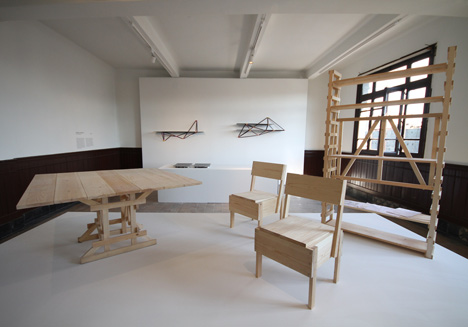
Ethel Baraona: In countries like Turkey, or Africa and Latin America, you can see that they are used to sharing knowledge of how to do things. And technology is just a tool; one more tool to expand this knowledge. So I think it’s interesting to people here, in a country where, when you walk around, you can see, for example you see the furniture that we have from [Enzo Mari’s 1974 project] Autoprogettazione [above] and then, 40 years later, on the roof, with Campo de Cebada [below], it is the same evolution that you can see here on the streets; people doing their own stuff.
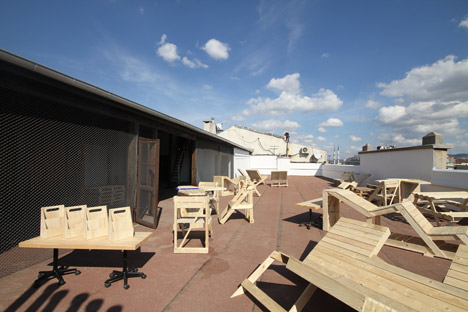
Elian Stefa: in some countries, in the developing world, there’s a lot more issues that may be smaller, that people can solve by themselves. This is exactly where adhocracy shines. But there’s another aspect to it; we have projects from all over the globe. The reason for that is because a lot of this maker spirit, a lot of this doing your own, finding your own solutions, is inherent in people. So you see really advanced open-source systems from advanced countries, and you see the sharing of information in a more informal way from developing countries. For example we have a project from Mumbai and Istanbul, Crafting Neighbourhoods, which talks about that. It’s not formally open-source. but it is in spirit.
Marcus Fairs: Could ad-hoc manufacturing systems emerge as a strong component of an economy in countries like Turkey, Nigeria or India first?
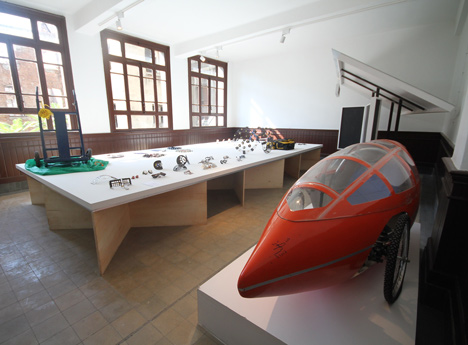
Joseph Grima: By its nature it’s always countries that are forced to seek out solutions that are not necessarily about buying off-the-shelf, turnkey solutions from corporate suppliers that are at an advantage in a way because they’re forced to explore other possibilities; how to achieve results without simply shelling out cash to buy boxed solutions to problems. And with that process of experiment, of trying to hack something together yourself, you’re initiating a chain reaction of innovation; a perpetual iteration of design. And that affects everything from product design to information technology. It ultimately boils down to the emergence of the network as the productive model par excellence of our time. It’s a complete shift away from the heroic figure of the designer towards the absence of any single figure as the author; more of a collaborative, networked approach. Maker Faire Africa [above and below] for example has links all over the world. It’s a global project. It’s very difficult to use national boundaries to contain phenomena in this day and age.
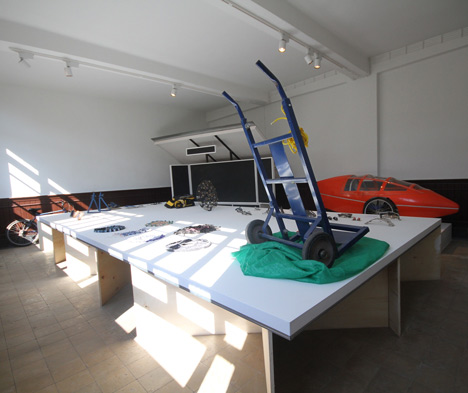
Marcus Fairs: Joseph, you curated an exhibition in Milan that explored similar themes [link]; this expands it beyond objects and into music software, film-making and things like that. But what is the next stage? If you were to do this again in a year’s time, how would it be different?
Joseph Grima: That’s an interesting question. Where do we go from here? There are significant differences between this show and the show in Milan, which was really intended to be seen in the context of the furniture fair, and in contrast to the model of the furniture fair, with the heroic figure of the designer, and show how new technologies are transforming dramatically not just the production process but also our idea of the design process today.
This exhibition is well beyond that and a lot of the projects here in the central void speak of a cultural shift that transcends the realm of technology. Pedro Reyes’ project for example is absolutely non-technological – it’s taking weapons and turning them into musical instruments – but at the same time it’s emblematic of this idea of hacking objects to transform them into something that is exponentially more powerful and completely subverts their use.
It’s something you see in technology; the Kinect [motion sensor for the Xbox 360 console] for example has been the most hacked object of the last year, but you also see it in the urban hackers UX, you see it in the spontaneous food festivals in Helsinki, you see it in countless projects, all the Arduino projects, in drones being used as a tactical approach to journalism, enabled by technology. It’s a kind of chain reaction in which these things can rise to the surface all together. So where to take it from here? This is an attempt to create a snapshot of a cultural condition at a particular moment in history. All of this will appear extremely commonplace and mundane to us in the future; in many ways it already does. It’s already part of the air we breathe.
One of the reasons the exhibition is so varied is that if we’d only had a few and they’d been homogenous it would have been, so what? So the attempt is to draw the lines, connect the dots between very diverse fields, and say it’s more than simply a technological revolution; it's a cultural revolution we’re undergoing now. And I think this is just the beginning. It’s very hard to tell where it will go but more and more it will impact the social and political realm. If you think about open data, data journalism, all of these projects are going to dramatically transform governments in the coming years. I think that would make an interesting show.
Ethel Baraona: I also think it has a very powerful approach to economic issues. Governments live from their economic power; things that create new trade, money, exchange with peer-to-peer design, these are transforming economic power. Maybe it’s just a starting point now but we could a big change, a revolution not only in social and government issues but also in governmental powers in a few years.
Marcus Fairs: What about the aesthetic issues? Designers have been the guardians of the aesthetic realm but it’s been undermined by the success of mass production. A lot of the objects in the exhibition are quite ugly by normal definitions; they’re quite difficult aesthetically. Where does this movement take our understanding of aesthetics?
Elian Stefa: I think beauty is in the eye of the beholder. That’s basically it.
Ethel Baraona: We now have the tools to understand the final form of the object; we can now see the process. So the final object is different. A few years ago the process was hidden. Now it gives a new approach to the final object. You can see that the object is different, but you can see why. So it’s changing the way we look at objects.
Joseph Grima: The point you bring up is the difficult and indigestible nature of certain objects in the exhibition. It was also a response to Deyan [Sudjic]’s provocation, the theme he proposed for the biennial, which was imperfection. And I think in a way imperfection, the way we understood the theme, was that if industrial production, the replication of multiples, was synonymous with perfection, then today perfection is almost frowned upon; it’s lost its cachet. It’s synonymous with the idea of one size fitting all.
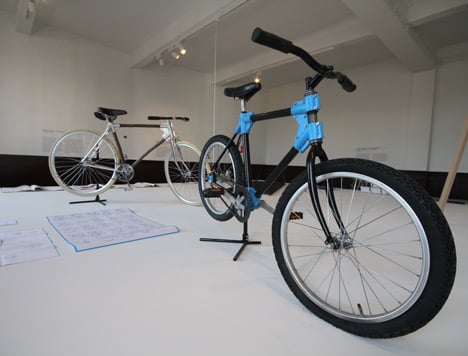
What is emerging is a culture that has an aesthetic of the appreciation of individualism, of user input. A lot of the projects have a kind of beauty tied to the fact that the user has a personal connection with that object. You think of Tristan Kopp’s ProdUSER bicycle [above] or Minale-Maeda’s Keystone coat hangers [below], these are objects in which [the user] has been involved in the production process. I think that creates a bond that transcends. Apart from the fact that I think they’re incredibly beautiful… or OpenStructures. The aesthetics are very different from that of the run-of-the-mill Argos toaster. It does have a beauty of its own. It’s almost a return to the earliest projects of industrial design, of Braun and a lot of those companies, there’s a return to that simplicity, of showing the elementary function of these objects. Making them accessible.
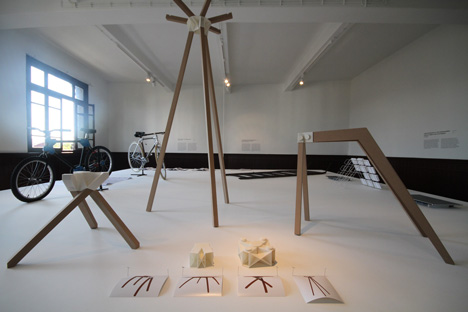
Marcus Fairs: So it’s forcing new ways of reading and understanding beauty.
Joseph Grima: Exactly.
Elian Stefa: We also have to understand that design is part of culture. Culture has to represent the political conditions and situations. Considering the fact that we just passed a major global economic crisis…
Joseph Grima: We just passed it?
Elian Stefa: Well, we’re still in the middle of it! But these kinds of conditions are the perfect breeding ground for projects like these. These projects express exactly that. They’re not really poor, the materials they use are not really poor, they’re just what is available now.
Joseph Grima: The aesthetics of an era are always an expression of its core values. And this imperfection of certain objects is something that has a value for us today. But also the machines… something we obliquely referenced is James Bridle’s theory of the New Aesthetic, which is a consequence of the permeation, the saturation of our lives with machines. The idea that machines are shaping not just how we do things but also how we perceive the world: that’s becoming part of our core consciousness. That’s something that we touched upon a little bit [in the exhibition], quite obliquely. But yeah, every era has had its own aesthetics, its own codes, and the codes of this era are definitely of a very different kind to those of the previous century.
See more stories about open design on Dezeen.